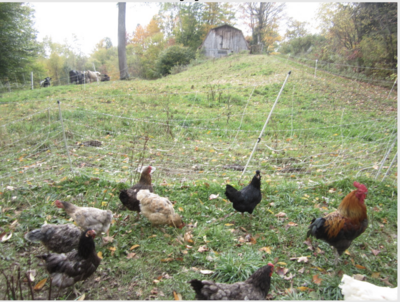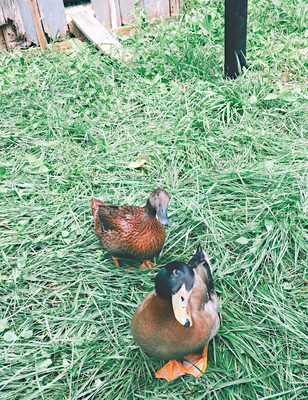Hi! So, recently I have been saving up money for a big(er) aviary (yes, it will take a few years to save up enough). I want to help you start your aviary journey!
Photo Courtesy of @-7-6- Left Image: "My flock having breakfast" Right Image: "My little polish roo, Cuddlebug"
New to birds- or long time owner?:
This article is meant for 1st-time-bird-owners, but anyone can read this for fun!
Photo Courtesy of @cooingdove "one our mixed flock free ranging with the cows in the back round"
What birds do you want/have?:
If you want (ie.) quail, then find out breeders, temperaments, etc.
Some birds are:
-Chickens
-Ducks
-Quail
-Geese
-Pheasants
-Peafowl (peacocks)
-Turkeys
-Exotic waterfowl----- please only buy if you have extreme experience with waterfowl- not "oh yeah, I had pekin ducks for like 2 months I'm ready " you want to have experience.
Photo courtesy of @prettylittlehens Khaki Campbells named "Sal and Sally"
Going down the road to addiction: hatching:
I know a few people (not just on BYC) that LOOOOVE hatching. Many people on BYC also love hatching.
Hatching eggs is a lot of work/ a little work depending on what incubator you get. Here are some standard incubators people like:
+Rcom 800 ($900)
+Brinsea Mini 2 ($115)
+Genesis hovabator ($100- $200) - I have heard the best reviews about this one
Things to consider when buying an incubator (thanks to an anonymous person for helping me with this section!)
-Is it going to contain heat and humidity, or is it going to fluctuate?
-How do you add in water? Through the bottom or a reservoir (reservoir incubators are more expensive)
-Turner? Automatic or Manual? You can buy turners pretty cheap. Manual turners you have to turn multiple times a day, which works if you are home A LOT.
Photo Courtesy of @Alyssa-Bee "My splash laced red wyandotte with an accidental single comb"
Where do you live?
Ok, so where you live matters. If you live in the upper states or canada, you might want to think about insulating your aviary. If you live in the southern states, (ie. Florida) you may not want to add insulation.
Living in an area with both: ie. Upstate NY- warm summers, cool winters. Add in a cozy area- but don't go overboard
Photos courtesy of @casportpony
Supplies:
These supplies are general bird supplies, but it helps to list them:
-Cages: you neeeed cages. I can't tell you how many times a cat carrier or a medium-sized dog crate has helped me. Rather if it's a hospital, transportation or an agressive bird's timeout, these cages are amazing. You can also save the little fold-up carriers made out of cardboard, they help with quail or chicks.
-Heat lamps: Some people heat their coops with heat lamps- personally, I wouldn't (I actually knew someone who heated their coop and the lamp caught on fire and their whole barn caught on fire). I would say have one laying around with 1-2 extra bulbs. Mainly, I use them for chicks or a sick bird who needs warmth.
-Shavings/Sand/ DE: Again, just my opinion when it comes to these things. Most people use shavings for chicks (do not and I repeat DO NOT get the fine-milled shavings, these cause respiratory issues and WILL kill your bird) but some people use them in coops. I use shavings in my quail's indoor hutch (where they only go when it's cold, and the shavings keep them warm). Sand is best for an area that gets a lot of activity. You just clean it out with a kitty-litter scoop. I use this in my chicken coop and quail hutch. Diatomaceous Earth I personally use, but I don't let my birds out until the dust has settled. DE can cause respitory issues if you/your birds breath in the dust. Once the dust has settled, you can let your birds out/back into the area. DE is good with preventing mites
-Food: I use DuMore poultry feed (you can use it for MANY birds, see back) I also use Manna pro flock party mealworms. In the winter I feed a mix of pumpkin purree and cracked corn (helps keep their weight up- DON'T GET OBESE BIRDS, JUST DON'T MAKE THEM SKIN AND BONES)
-Other: I can't think of anything else off the top of my head, but just have extra buckets, feeders/ waterers laying around
-Emergency stuff: There are many different things you can add to an emergency bag, but I'm pretty minimalistic when it comes to my emergency bag; blood stop powder, medical bandages, tape (for curled toes), medical tape, vetericyn poultry wound spray, Sav-a-chick electrolytes (for adults too), Sav-a-chick probiotics (for adults too), Vet Rx Poultry remedy, oral syringes.
Photo Courtesy of @Gonzalezfam "Cuckoo Maran"
Getting Your birds:
There are many places you can get birds from. With COVID, I think that we will all be shopping for birds online, although some of us might still go to feed stores for chicks. Here are some links:
Meyer Hatchery- Many rare waterfowl breeds, such as swans and ruddy ducks
Cackle Hatchery- For years I recive cackle hatchery magazines (?) and they seem to have basic breeds
Purely Poultry- I blame purely poultry for introducing me to what a snowflake bobwhite quail is. Ok, all messing around aside, this is a great website with a TON of different kinds of birds
Murray McMurray Hatchery
Stromberg's hatchery
My pet chicken- sells rare breeds and fun acsessories
Photo courtesy of @KiwiAndPeachThePigeons123
Um...What?: Saddles, Costumes and harnesses:
+Saddles: Sadlles are for birds who... how do I put this lightly..... get the male's attention (you know what I mean). Males tend to be aggressive while breeding, and when a hen has her saddle (feathers before tail) gone (and it's not a molt), then you may need a saddle, which prevents damage to her feathers. If you choose to give your hen a saddle, it may take her a little bit of time for her to adjust to it.
+Costumes: 100% optional. Want ideas? Go to BYC's Critter Costume Contest!
+Harnesses: Again, optional. I use harnesses when I take my birds out to the feed store, and when I was in 4H I would use a harness when I was the poultry area's greeter for a day (you stand at the door and offer for peeps to pet your bird). These also come with leashes, but my birds HATE leashes: they're ok with the harness.
----------All of these can be found on My Pet Chicken's website----------
Photo Courtesy of @Love my chickens 25
Identification:
With certain birds you can tell males and females apart, but you can't tell the same gender apart. That's when it comes to identification methods.
+Toe punch: common in turkeys. Toes are "punched" using a special toe web puncher. The toe web is the web-like skin that's fleshy and in-between toes. I personally would never toe punch MY birds, but everyone is different. The main attraction to toe (web) punching is that the holes will be there forever, unlike a leg band which may come off. The downside of toe punching is that the toe web may become infected, and infection is common.
+Wing bands: I have heard of this before in pigeons. Wing bands are metal bands that are put in a bird's wing web (I know, lot's of "webs" in this section). These metal bands may come off, but usually don't. The attraction is easy identification, the downside is that wing bands are not readily available.
+Leg bands: Most people I know use leg bands. They are safe to use and VERY easy to find. You don't even need leg bands, you can use colored zip ties. Leg bands are the safest, and there is only an extremely rare case where a bird may eat it, so nothing to worry about. When putting on a legband, it should be tight enough so that it will not slide off, but loose enough so that it isn't hurting the bird. The attractions to leg bands is that they are readily available, easy to use (literally anyone can put on a leg band), they don't cause harm and that they come in MANY different colors (there's even ones that have little charms, you can buy them here). The downside is that people forget about bands and they grow (especially if you band chicks-please resist the urge to band and identify at their young age- wait until 10 weeks please).
Photo courtesy of @Love my chickens 25
Inspiration!:
When building your aviary (big or small), you may not know where to start, and you may not even have any ideas! Here's some places to look:
+Pinterest- you may find something cool, or you might waste time (since that's Pinterest!)
+Youtube- there are a ton of farmer-bird owner youtubers. My favorite (who I have gotten inspired by) is Jason at Cog Hill Farm's youtube. He's upbeat and he has a lot of ideas for projects that don't cost too much (plus their goats are super cute- I figured out what goat breed I wanted from watching his channel!- Nigerian Dwarf Goats)
+Driving through farm country-when I FIRST got goats, I drove around looking at a lot of farms. I'm still inspired by someone who lives 5 minutes away from me (she has emus + horses)
+Tractor Supply/ Feedstores- This will be dangerous, and I advise you bring no money with you, so that you can't buy chicks
 . I'm a little bit weird, since I get inspired by looking at gates, feed bags, waterers, horse/goat/bird medicine etc. That whole little nook in the corner of the store is where I like (figuratively).
. I'm a little bit weird, since I get inspired by looking at gates, feed bags, waterers, horse/goat/bird medicine etc. That whole little nook in the corner of the store is where I like (figuratively).Photo Courtesy of @RoostersAreAwesome
Prevention: Your best friend
Chicken Wire?
Nope. please PLEASE avoid chicken wire. Chipmunks can climp through the holes and raccoons/opossums can stick their nose in and grab a chickens. Instead, please use hardwear cloth. The small holes allow bugs in and airflow (your birds will appreciate both) and no predators can harm your birds.
Flying'........ AWAY!
I have read a few threads where people are like, "my quail/pheasant flew out of the coop!" to prevent this by adding a "cage" of hardware cloth around the enclosure, so that if the bird does escape the coop/ flight pen, you can get it without the bird outsmarting you.
Photo Courtesy of @RIR chicks
Before you go:
For research, go to BYC's sticky topics part of each section
Image Credit Left to right: @kelzey , @TwoCrows
Thanks for reading!





